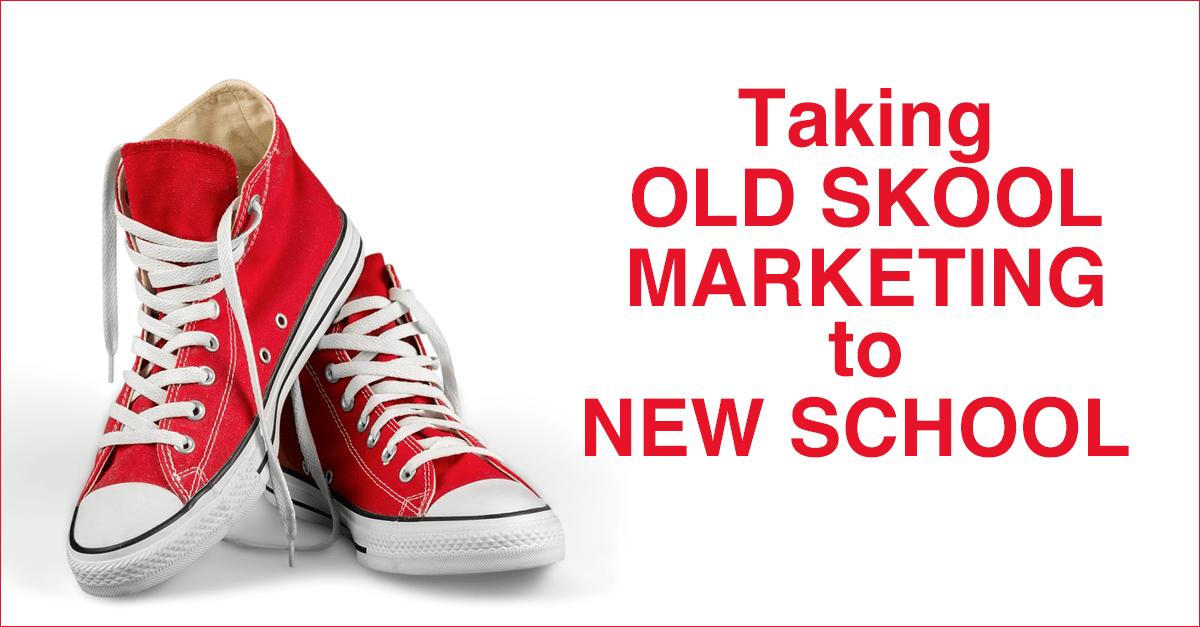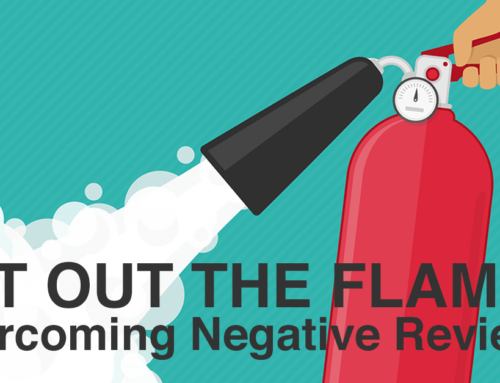Perhaps this reflects a bit of reverse ageism…but our generation marketed in different ways than millenials, sometimes actually for the better. In many ways, Old Skool Marketing was harder than New School Marketing. We had to hustle and sweat to get our messages found and heard, and we didn’t just do it from behind a keyboard or mobile phone. If I sound like a curmudgeon, I’m not – I actively practice New School Marketing techniques. But for the benefit of those born before the advent of Apple Computer as well as those who came after Spice Girls topped the charts, we explore the best ways to think about taking Old Skool Marketing tactics to New School Marketing and back.
Television Ads
It feels almost senseless to see the crazy amounts of money corporations spend for Super Bowl ads in this era. How can it provide a reasonable return on investment (especially since you cannot measure the results easily or accurately)? Contrast television advertising with YouTube and YouTube ads, where you can reasonably count the number of viewers, views and clicks on ads. It’s even more cost effective because it’s not $2 million for 30 seconds (and one shot where someone could be in the loo!); you pay for what you get.
Action Items:
- Consider trying a small advertising budget for YouTube.
- Also consider creating a channel and making a series of videos to promote your product or service.
Radio Ads
Do you listen to terrestrial radio often? Well, podcasts are the new radio. It’s amazing how many one-time radio celebrities (e.g., Adam Carolla, Bill O’Reilly, Ryan Seacrest) have created podcasts. Many podcasters make more money than anyone (Limbaugh & Stern excluded) than almost anyone in radio. Podcasts are a far more portable, accessible medium than radio. Most professional podcasts have interstitial ads or sponsors announced by the host during the show.
Action Items:
- Explore sponsoring a podcast in your market (e.g., local, industry). Costs are typically low and it’s narrow in focus.
- If you are interested in creating your own podcast, there are many articles that guide you to a setup and understanding – be forewarned that it’s challenging to do and more difficult to market than you expect.
Print Ads
Have you noticed the declining quantity and size of print publications? Newspapers are thin, and magazines seem to be disappearing (except at the airport). Remember when you used the Yellow Pages to find a vendor (maybe not!)? Clearly the web disrupted old skool marketing with traditional print media. Like television, measuring the effectiveness of ads was almost always anecdotal. Google AdWords and Facebook (and Instagram) ads have taken over. Not only are they budget-friendly, they are far more focused and measurable. You can define precise audiences, test specific campaign ideas and direct ads to split-tested landing pages to improve conversion rates.
Action Items:
- Do some homework on the kinds of ads companies run in your industry (services like SEMRush.com help).
- If you aren’t already running any AdWord campaigns, set aside a small budget to try it.
- Try running new Facebook or Instagram campaigns – set aside another budget to try it.
- B2B vendors should look at LinkedIn ads. Costs are quite reasonable and ads get in front of the people you want.
Press Releases
Although media has changed, press releases are, well, still press releases. The nature of press releases remains largely intact. You can get media coverage, but you’re best served by creating a story about your product and service that’s more than just an announcement. For example, you can roll out a successful case study, release success statistics or highlight an interesting group of customers. The bottom line is that press releases can still actually be effective. We do recommend using press release services, either free or paid, to distribute them. Why? These services create links to your site, and referral traffic is a good thing.
Action Items:
- What could you write an interesting press release about? Write a short one for a test.
- Research the paid newswire services (e.g., PRWeb, PRNewswire) for rates to distribute your test press release. Can you afford it?
- Research industry newswire services. In one job I had, we used one specific to the music industry – a basic release was free, and they offered inexpensive paid upgrades.
Print Reviews
Back in the old skool marketing days, I carried out media relations work for a software company. We wrote traditional press releases and “serviced” them with industry publications with phone calls, FAX messages and in-person meetings. Our goal was to get a positive write-up (“there is no such thing as bad press”) in one of these journals because they heavily influenced buyers. Today, we have Yelp, Amazon and Google Places sharing with us what other customers think. A 5-star review on Yelp or a negative review on Amazon can easily sway a customer. So getting good reviews, assuming you deliver a good product or service, is essential to driving more new business (we’ve talked extensively about social proof…).
Action Items:
- Audit your business reviews on Yelp, Google Places and Amazon, as applicable. Respond positively to any online feedback. Don’t argue, but respond…
- If you can add reviews, testimonials, customer logos and certifications on your own website, do so! The more you add, the better. Make sure they are prominent and obvious. We prefer reviews to be embedded within the site rather than one a single ‘testimonials’ page (though you can do both).
FAX
In another marketing role, we created something called FastFAX. When a customer called about a product, we could get their FAX number and immediately send them a one-sheet brochure. At the time, it was impressive because it was near real-time delivery. Today, we achieve even better results using autoresponders via email. When someone signs up for your email list, you can immediately send them a free resource, a list of your best blog posts or a discount on their first purchase. You can even design different offers for different kinds of registrations (e.g., a product inquiry versus a newsletter subscription). Autoresponders are typically free, powerful and flexible in an email service…
Action Items:
- Are you using autoresponders? If not, set one up! If so, review and see if the messaging is good.
- Consider segmenting your list and delivering different responses based on the customer journey.
- Consider running split-tests on the autoresponders to find optimal customer results.
Networking
As a long-time software and website developer, I tend to hide in the bunker too much. Unfortunately, when we get busy on projects, we forego social interaction (trust me, it’s for your own good – we’re not easy to talk to!). That said, networking is a critical activity for nearly every business. As Keith Ferrazi wrote in his amazing book Never Eat Alone, the power of the network isn’t who you meet or know, it’s who THEY know. Make connections and you can tap their connections. We help our friends all the time… “Hey, know a web guy?” “Why, yes, call my friends over at Twisted Puppy!”
Used properly, social networks can have a similar impact. We all hate the guy at the networking event who is there to sell the snot out of his company, and we all have the same response on LinkedIn, Facebook, Twitter and Meetup if you come on too strong. To get best outcomes, don’t offer your service – be of service.
Action Items:
- Sign in to Meetup.com and look for a new event to attend in your community.
- Read Never Eat Alone by Keith Ferrazzi.
- Refer someone you know to a colleague (give to get…).
Conferences and Trade Shows
Like cockroaches and press releases, conferences and industry trade shows have survived disruption from the internet. Many events offer valuable face time with peers, vendors, customers and media. Consolidation among events has left fewer of them in certain industries, so options can be limited. That said, if you find one on the calendar, it may be worth your time to learn more about what’s happening in the trenches. Thinking about expanding into fiber optics? Visit an industry show to see what everyone is talking about. Get out of the bunker, visit a different part of the world and learn.
Action Items:
- Research the leading conferences and trade shows in your market. What would it cost in time & resources to attend?
- If you attend an event, have a solid plan before you go. Ask us for ideas – we’re glad to share a checklist.
- Research virtual trade shows. Yes, it’s a thing.
Snail Mail
Gone are the days of huge print advertising budgets and brochure mailers. Remember getting all those catalogs stuffed in your mailbox? It was fun to look at, but someone had to pay for it. Now we have so many more options. But believe it or not, don’t forget about good old-fashioned mail. It’s an underused channel and could work for you. Sure, you can send your monthly newsletter for pennies, and you should. But you can also sneak a card in the mail, direct a customer to a special offer via a special URL and get amazing results. We love combinations. Here’s a great idea from 1998 that could still work. Back then, I think it was Lands End sent out a catalog with a tear-out card with an offer that directed to a special URL (e.g., landsend.com/shhhhhh). The link was a ‘secret’ for insiders. The idea was unique. The action was trackable. And I’m confident it worked (neuroscientifically sound!).
Don’t forget that costs of printing can be managed far better. Think about on-demand printing services. You can print inexpensively with vendors like FedEx, VistaPrint (buy the upgrades if you do) or Moo.
Action Items:
- Can you benefit from a postcard or simple one-page brochure to mail out?
- What would it cost to send a small test in your target market? Can you get a list?
Taking Old Skool Marketing to New School
I recommend reading the works of Claude Hopkins, the godfather of advertising. That’s the best old skool marketing you can get. Then have a look at Traction by Gabriel Weinberg and Justin Mares. You’ll see some antiquated ideas in Hopkins, but also find some aha‘s to try. I see a strong correlation to Hopkins’ approach and writing AdWords or Facebook ads. Traction will show you many new school variations that can up your marketing game.
In the end, marketing has always been about Attention | Interest | Desire | Action – some old skool marketing techniques are underutilized now and can work, and some new school tactics are essential to stay alive. Take old skool marketing to new school and you’ll undoubtedly learn something, perhaps that you’ve forgotten how good something worked before!
Useful Links for Taking Old Skool Marketing to New School
Never Eat Alone
Claude Hopkins
Traction
PR Newswire
PR Web
20+ Free Press Release Distribution Sites
How to Make a Podcast
How To Podcast: The Ultimate Guide to Podcasting





![Video Engagement [Infographic]](https://twistedpuppy.com/wp-content/uploads/2017/08/twisted-puppy-blog-video-engagement-1-500x383.png)


Leave A Comment